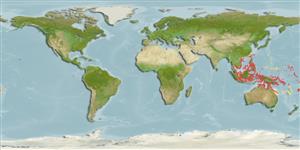Common names from other countries
Teleostei (teleosts) >
Gobiiformes (Gobies) >
Gobiidae (Gobies) > Gobiinae
Etymology: Cryptocentrus: Greek, kryptos = hidden + Greek, kentron = sting (Ref. 45335).
More on author: Herre.
Environment: milieu / climate zone / depth range / distribution range
Ecology
Marine; reef-associated; depth range 1 - 25 m (Ref. 27115), usually 10 - 25 m (Ref. 48637). Tropical; 22°C - 28°C (Ref. 27115); 25°N - 24°S
Western Pacific: Yaeyama Islands, Japan to Singapore and the southern Great Barrier Reef; Palau and Truk in Micronesia.
Size / Weight / Age
Maturity: Lm ? range ? - ? cm
Max length : 10.0 cm SL male/unsexed; (Ref. 48637)
Dorsal
spines
(total): 7;
Dorsal
soft rays
(total): 10;
Anal
spines: 1;
Anal
soft rays: 9. Predorsal scales absent. Occurs in two color phases, one yellow and the other with whitish ground color; both forms with 4-5 dusky bars (although faint in yellow fish) and fine pale blue or white spotting on head and anterodorsal part of body and fins. A dark brown streak above maxilla (Ref. 27362); further characterized by: brown snout; presence of thin brown line along edge of upper jaw; united pelvic fins, presence of frenum; longitudinal scale series 92-95; head without scales; greatest depth of body 4.4-4.6 in SL; rounded caudal fin, about equal to head length (Ref. 90102).
Inhabits sandy areas of shallow lagoons and protected coastal bays (Ref. 9710). Lives in a burrow with alpheid shrimps. Found in clear coastal sand slopes and lagoons, usually in depth of 10-25 meters (Ref. 48637).
Life cycle and mating behavior
Maturity | Reproduction | Spawning | Eggs | Fecundity | Larvae
Myers, R.F., 1991. Micronesian reef fishes. Second Ed. Coral Graphics, Barrigada, Guam. 298 p. (Ref. 1602)
IUCN Red List Status (Ref. 130435)
CITES (Ref. 128078)
Not Evaluated
Threat to humans
Harmless
Human uses
Aquarium: commercial
More information
Common namesSynonymsMetabolismPredatorsEcotoxicologyReproductionMaturitySpawningFecundityEggsEgg development
ReferencesAquacultureAquaculture profileStrainsGeneticsElectrophoresesHeritabilityDiseasesProcessingMass conversion
Tools
Special reports
Download XML
Internet sources
Estimates based on models
Preferred temperature (Ref.
115969): 26.3 - 29.1, mean 28.4 (based on 502 cells).
Phylogenetic diversity index (Ref.
82804): PD
50 = 0.5000 [Uniqueness, from 0.5 = low to 2.0 = high].
Bayesian length-weight: a=0.00708 (0.00333 - 0.01504), b=3.09 (2.92 - 3.26), in cm Total Length, based on LWR estimates for this (Sub)family-body shape (Ref.
93245).
Trophic level (Ref.
69278): 3.4 ±0.4 se; based on size and trophs of closest relatives
Resilience (Ref.
120179): High, minimum population doubling time less than 15 months (Preliminary K or Fecundity.).
Fishing Vulnerability (Ref.
59153): Low vulnerability (10 of 100).
